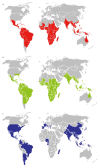Is transfusion-transmitted dengue fever a potential public health threat?
- PMID: 25964876
- PMCID: PMC4419115
- DOI: 10.5501/wjv.v4.i2.113
Is transfusion-transmitted dengue fever a potential public health threat?
Abstract
Dengue is an arboviruses due to single-stranded enveloped ribonucleic acid viruses, named dengue viruses (DENV), that include four serotypes and are mainly transmitted via the bite of mosquitoes of the genus Aedes (A. aegypti and A. albopictus). The distribution of the disease was historically limited to intertropical areas; however, during the last thirty years, the perimeter of the disease extended considerably and temperate areas are now at risk of outbreaks. The present global burden of dengue is considerable: 2.5 billion people over more than 100 countries are concerned; 50 to 100 million infections occur every year, with a number of fatal cases of approximately 20000. Although frequently asymptomatic or limited to a mild fever, dengue is responsible for severe cases mainly consecutive to the occurrence of hemorrhagic complications that can lead to shock and death, notably in children from poor-resource settings. The place of DENV as a transfusion-transmitted pathogen has been recognized only in 2008. At the present time, only five cases of transfusion-transmitted dengue, including one case of dengue hemorrhagic fever, have been formerly documented. This review provides a general overview of dengue, its viruses and their vectors. It replaces the disease in the context of other viral diseases transmitted by arthropods. It discusses the threat of dengue on the supply of blood products in endemic and non endemic areas. Finally, it describes the specific and non specific measures available for improving the security of blood products with regards to this emerging risk. Interestingly, in 2009, the American Association of Blood Banks placed DENV in the highest category of emerging infectious agents for their potential impact on transfusion recipient safety for the next years in North America.
Keywords: A. aegypti; A. albopictus; Blood safety; Dengue; Dengue viruses; Transfusion-transmitted virus.
Figures



References
-
- World Health Organization. Dengue and severe dengue [updated March 2014] Available from: http: //www.who.int/mediacentre/factsheets/fs117/en/
-
- Normile D. Tropical medicine. Surprising new dengue virus throws a spanner in disease control efforts. Science. 2013;342:415. - PubMed
-
- Alves MJ, Fernandes PL, Amaro F, Osório H, Luz T, Parreira P, Andrade G, Zé-Zé L, Zeller H. Clinical presentation and laboratory findings for the first autochthonous cases of dengue fever in Madeira island, Portugal, October 2012. Euro Surveill. 2013;18 - PubMed
-
- Wilder-Smith A, Quam M, Sessions O, Rocklov J, Liu-Helmersson J, Franco L, Khan K. The 2012 dengue outbreak in Madeira: exploring the origins. Euro Surveill. 2014;19:20718. - PubMed
-
- Gjenero-Margan I, Aleraj B, Krajcar D, Lesnikar V, Klobučar A, Pem-Novosel I, Kurečić-Filipović S, Komparak S, Martić R, Duričić S, et al. Autochthonous dengue fever in Croatia, August-September 2010. Euro Surveill. 2011;16 - PubMed
Publication types
LinkOut - more resources
Full Text Sources
Other Literature Sources

